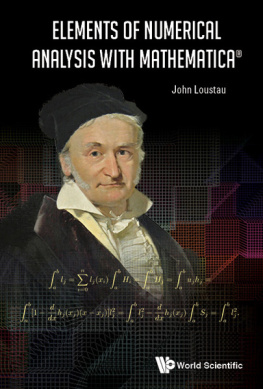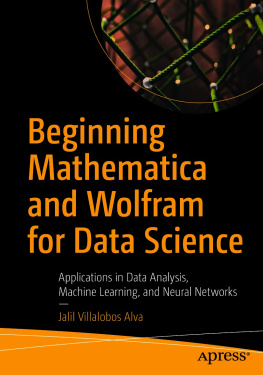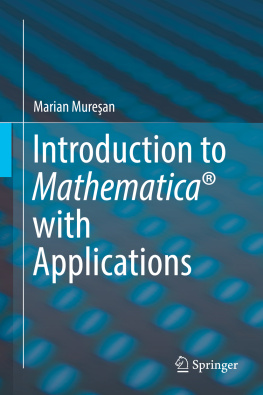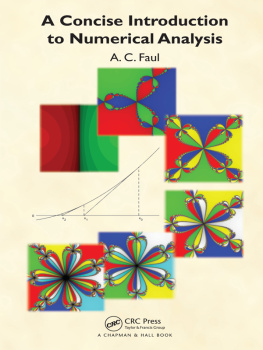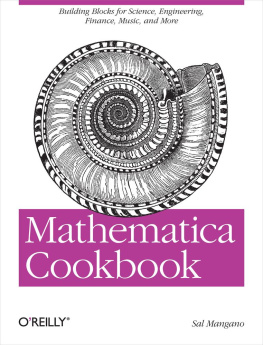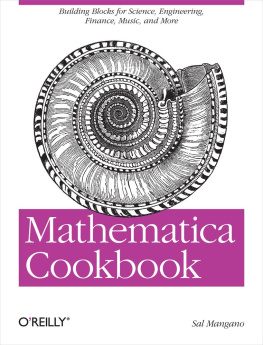John Loustau - Elements of Numerical Analysis with Mathematica
Here you can read online John Loustau - Elements of Numerical Analysis with Mathematica full text of the book (entire story) in english for free. Download pdf and epub, get meaning, cover and reviews about this ebook. year: 2017, publisher: WSPC, genre: Home and family. Description of the work, (preface) as well as reviews are available. Best literature library LitArk.com created for fans of good reading and offers a wide selection of genres:
Romance novel
Science fiction
Adventure
Detective
Science
History
Home and family
Prose
Art
Politics
Computer
Non-fiction
Religion
Business
Children
Humor
Choose a favorite category and find really read worthwhile books. Enjoy immersion in the world of imagination, feel the emotions of the characters or learn something new for yourself, make an fascinating discovery.
- Book:Elements of Numerical Analysis with Mathematica
- Author:
- Publisher:WSPC
- Genre:
- Year:2017
- Rating:4 / 5
- Favourites:Add to favourites
- Your mark:
- 80
- 1
- 2
- 3
- 4
- 5
Elements of Numerical Analysis with Mathematica: summary, description and annotation
We offer to read an annotation, description, summary or preface (depends on what the author of the book "Elements of Numerical Analysis with Mathematica" wrote himself). If you haven't found the necessary information about the book — write in the comments, we will try to find it.
Elements of Numerical Analysis with Mathematica — read online for free the complete book (whole text) full work
Below is the text of the book, divided by pages. System saving the place of the last page read, allows you to conveniently read the book "Elements of Numerical Analysis with Mathematica" online for free, without having to search again every time where you left off. Put a bookmark, and you can go to the page where you finished reading at any time.
Font size:
Interval:
Bookmark:


Published by
World Scientific Publishing Co. Pte. Ltd.
5 Toh Tuck Link, Singapore 596224
USA office: 27 Warren Street, Suite 401-402, Hackensack, NJ 07601
UK office: 57 Shelton Street, Covent Garden, London WC2H 9HE
Library of Congress Cataloging-in-Publication Data
Names: Loustau, John, 1943 author.
Title: Elements of numerical analysis with Mathematica / by John Loustau (Hunter College, City University of New York, USA).
Description: New Jersey : World Scientific, 2017. | Includes bibliographical references and index.
Identifiers: LCCN 2017020923| ISBN 9789813224155 (hardcover : alk. paper) | ISBN 9789813222717 (pbk : alk. paper)
Subjects: LCSH: Numerical analysis--Study and teaching (Higher) | Numerical analysis--Data processing. | Mathematica (Computer file)
Classification: LCC QA297 .L68 2017 | DDC 518--dc23
LC record available at https://lccn.loc.gov/2017020923
British Library Cataloguing-in-Publication Data
A catalogue record for this book is available from the British Library.
Copyright 2018 by World Scientific Publishing Co. Pte. Ltd.
All rights reserved. This book, or parts thereof, may not be reproduced in any form or by any means, electronic or mechanical, including photocopying, recording or any information storage and retrieval system now known or to be invented, without written permission from the publisher.
For photocopying of material in this volume, please pay a copying fee through the Copyright Clearance Center, Inc., 222 Rosewood Drive, Danvers, MA 01923, USA. In this case permission to photocopy is not required from the publisher.
Printed in Singapore
To my adviser, Adil Yaqub and to all my teachers
This book is an introduction to numerical analysis. It is intended for third or fourth year undergraduates or beginning master level students. The required background includes multivariate calculus and linear algebra. Some knowledge of real analysis is recommended. In terms of programming, some programming experience would be a plus but is not required. Indeed, the book is self-contained in this respect. But, the treatment is likely too fast for some beginners.
The programming environment is Mathematica, a 4GL with an advanced symbolic manipulation component. We make an effort to keep the programming component simple. In particular, we use as little of the programming language as possible. We are currently using Version 10. However, this material has been developed and used over a period of years. There are some programming changes or additions included in more recent versions. But none of these affect the programs included in this text. With Version 10, Mathematica is also referred to as Wolfram Language.
The purpose is to introduce numerical analysis. Since the post WWII period, [Grcar (2011)], numerical analysis has been the mathematics supporting large calculations carried out on a computer. Hence, a course in this topic must include computational exercises and these should be large enough or sufficiently complex to warrant the use of a computer. It is better still if there are realistic problems; ones that the student can imagine would arise in an actual application.
One dominant application of numerical techniques concerns simulating processes represented by differential equations. In this setting, we are charged with estimating the existent but unknown solution to a differential equation. We have organized the topics of this book to introduce some of the classical approaches to this problem. In particular, we develop finite difference method (FDM) for a parabolic equation in one spatial variable, including explicit, implicit and Crank-Nicolson FDM. In addition, we touch on stability. In another direction, we present some of the elementary techniques used to simulate the solution of an ordinary differential equation. Monte Carlo method is another means to simulate a differential equation. We present the basics of this method. We include the simulation of a stochastic differential equation.
Another area of current interest is certain Big Data applications. The solution procedures for problems that arise in this area include solving large linear systems of equations. Generally, these systems are too large for Gauss-Jordan elimination. We will develop two basic solution procedures including Gauss-Seidel. In this context, we introduce the student to the basics of Krylov subspaces. Another aspect of Big Data applications is optimization, multivariate max/min problems. This is also an important part of our development. We include both the greatest descent and Hessian variants.
We present the techniques of numerical analysis together with the supporting theory. Much of this book is organized in traditional definition, theorem, proof format. With a small number of exceptions, the theory is self-contained within this text and prerequisites. In the exceptional cases, the necessary supporting material is identified and referenced. But, full understanding of the material requires both knowledge of the mathematical foundations and hands on experience. In this regard, we include examples and exercises that are beyond what can be done with pencil and paper. In this way, we emphasize the natural link between numerical analysis and computing.
We present the material of the text in the given order. It is intended to be a one semester course. Programming in Mathematica is sufficiently intuitive for students with math or engineering background that little or no programming background is necessary. In fact, the readers experience manually solving problems provides the necessary foundation toward programming sophisticated processes. At the same time, we find it useful to schedule computer lab time for the first few weeks of the semester. In this facility, we can provide one-on-one programming support. By mid-semester all students are on an even footing programming-wise.
For most students this class is a rewarding experience. In this setting, they are able to solve problems that are realistic in scale and complexity. To this point, their prior experience is often restricted to problems that can be executed easily with pencil and paper.
In many respects a course based on this text would function as a capstone course for the undergraduate. This is because it calls upon so much of a students undergraduate experience, calculus, single and multivariate, vector calculus, linear algebra, real analysis, ODE and PDE and probability.
This text arose from our need of a beginning numerical analysis text that was sufficiently mathematical for our students and supported Mathematica as the programming platform. During that time, our students have seen topics come and go as we settled on a stable course. Without their participation this text could not have been written. Special acknowledgement goes to those who helped me understand how to present this material. In particular, this includes Scott Irwin, Yevgeniy Milman, Andrew Hofstrand, Evan Curcio, Gregory Javens and James Kluz.
Special acknowledgment goes to those who helped me understand how to present this material. In particular, this includes Scott Irwin, Yevgeniy Milman, Andrew Hofstrand, Evan Curcio, Gregory Javens, Hassan Mahmood and James Kluz.
About the Cover: Carl Friedrich Gauss was a giant among mathematicians. There are several signature procedures attributed to Gauss that arise in the text. For instance, Gaussian quadrature is often considered the
Next pageFont size:
Interval:
Bookmark:
Similar books «Elements of Numerical Analysis with Mathematica»
Look at similar books to Elements of Numerical Analysis with Mathematica. We have selected literature similar in name and meaning in the hope of providing readers with more options to find new, interesting, not yet read works.
Discussion, reviews of the book Elements of Numerical Analysis with Mathematica and just readers' own opinions. Leave your comments, write what you think about the work, its meaning or the main characters. Specify what exactly you liked and what you didn't like, and why you think so.

